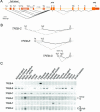Regulation of the MiTF/TFE bHLH-LZ transcription factors through restricted spatial expression and alternative splicing of functional domains
- PMID: 15118077
- PMCID: PMC419459
- DOI: 10.1093/nar/gkh571
Regulation of the MiTF/TFE bHLH-LZ transcription factors through restricted spatial expression and alternative splicing of functional domains
Abstract
The MiTF/TFE (MiT) family of basic helix-loop-helix leucine zipper transcription factors is composed of four closely related members, MiTF, TFE3, TFEB and TFEC, which can bind target DNA both as homo- or heterodimers. Using real-time RT-PCR, we have analyzed the relative expression levels of the four members in a broad range of human tissues, and found that their ratio of expression is tissue-dependent. We found that, similar to the MiTF gene, the genes for TFEB and TFEC contain multiple alternative first exons with restricted and differential tissue distributions. Seven alternative 5' exons were identified in the TFEB gene, of which three displayed specific expression in placenta and brain, respectively. A novel TFEC transcript (TFEC-C) encodes an N-terminally truncated TFEC isoform lacking the acidic activation domain (AAD), and is exclusively expressed in kidney and small intestine. Furthermore, we observed that a considerable proportion of the TFEC transcripts splice out protein-coding exons, resulting in transcription factor isoforms lacking one or more functional domains, primarily the basic region and/or the AAD. These isoforms were always co-expressed with the intact transcription factors and may act as negative regulators of MiTF/TFE proteins. Our data reveal that multiple levels of regulation exist for the MiTF/TFE family of transcription factors, which indicates how these transcription factors may participate in various cellular processes in different tissues.
Figures



Similar articles
-
Cloning and characterization of the murine genes for bHLH-ZIP transcription factors TFEC and TFEB reveal a common gene organization for all MiT subfamily members.Genomics. 1999 Feb 15;56(1):111-20. doi: 10.1006/geno.1998.5588. Genomics. 1999. PMID: 10036191
-
TFEC is a macrophage-restricted member of the microphthalmia-TFE subfamily of basic helix-loop-helix leucine zipper transcription factors.J Immunol. 1999 Feb 1;162(3):1559-65. J Immunol. 1999. PMID: 9973413
-
Mitf and Tfe3, two members of the Mitf-Tfe family of bHLH-Zip transcription factors, have important but functionally redundant roles in osteoclast development.Proc Natl Acad Sci U S A. 2002 Apr 2;99(7):4477-82. doi: 10.1073/pnas.072071099. Proc Natl Acad Sci U S A. 2002. PMID: 11930005 Free PMC article.
-
Mitf and Tfe3: members of a b-HLH-ZIP transcription factor family essential for osteoclast development and function.Bone. 2004 Apr;34(4):689-96. doi: 10.1016/j.bone.2003.08.014. Bone. 2004. PMID: 15050900 Review.
-
Melanocytes and the microphthalmia transcription factor network.Annu Rev Genet. 2004;38:365-411. doi: 10.1146/annurev.genet.38.072902.092717. Annu Rev Genet. 2004. PMID: 15568981 Review.
Cited by
-
Id2 Mediates Differentiation of Labyrinthine Placental Progenitor Cell Line, SM10.Stem Cells Dev. 2016 Jul 1;25(13):959-74. doi: 10.1089/scd.2016.0010. Epub 2016 Jun 17. Stem Cells Dev. 2016. PMID: 27168216 Free PMC article.
-
Transcription factors TFE3 and TFEB are critical for CD40 ligand expression and thymus-dependent humoral immunity.Nat Immunol. 2006 Oct;7(10):1082-91. doi: 10.1038/ni1378. Epub 2006 Aug 27. Nat Immunol. 2006. PMID: 16936731 Free PMC article.
-
The Regulation of MiTF/TFE Transcription Factors Across Model Organisms: from Brain Physiology to Implication for Neurodegeneration.Mol Neurobiol. 2022 Aug;59(8):5000-5023. doi: 10.1007/s12035-022-02895-3. Epub 2022 Jun 4. Mol Neurobiol. 2022. PMID: 35665902 Free PMC article. Review.
-
Gene expression profiling of alveolar soft-part sarcoma (ASPS).BMC Cancer. 2009 Jan 15;9:22. doi: 10.1186/1471-2407-9-22. BMC Cancer. 2009. PMID: 19146682 Free PMC article.
-
Novel roles for the MiTF/TFE family of transcription factors in organelle biogenesis, nutrient sensing, and energy homeostasis.Cell Mol Life Sci. 2014 Jul;71(13):2483-97. doi: 10.1007/s00018-014-1565-8. Epub 2014 Jan 30. Cell Mol Life Sci. 2014. PMID: 24477476 Free PMC article. Review.
References
-
- Hemesath T.J., Steingrimsson,E., McGill,G., Hansen,M.J., Vaught,J., Hodgkinson,C.A., Arnheiter,H., Copeland,N.G., Jenkins,N.A. and Fisher,D.E. (1994) Microphthalmia, a critical factor in melanocyte development, defines a discrete transcription factor family. Genes Dev., 8, 2770–2780. - PubMed
-
- Fisher D.E., Carr,C.S., Parent,L.A. and Sharp,P.A. (1991) TFEB has DNA-binding and oligomerization properties of a unique helix–loop–helix/leucine-zipper family. Genes Dev., 5, 2342–2352. - PubMed
-
- Hodgkinson C.A., Moore,K.J., Nakayama,A., Steingrimsson,E., Copeland,N.G., Jenkins,N.A. and Arnheiter,H. (1993) Mutations at the mouse microphthalmia locus are associated with defects in a gene encoding a novel basic-helix–loop–helix-zipper protein. Cell, 74, 395–404. - PubMed
-
- Steingrimsson E., Tessarollo,L., Reid,S.W., Jenkins,N.A. and Copeland,N.G. (1998) The bHLH-Zip transcription factor Tfeb is essential for placental vascularization. Development, 125, 4607–4616. - PubMed
Publication types
MeSH terms
Substances
LinkOut - more resources
Full Text Sources
Molecular Biology Databases

